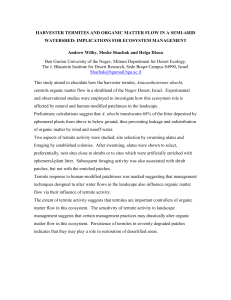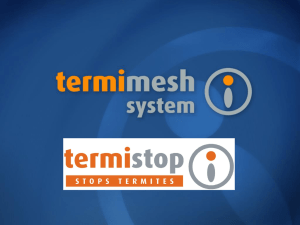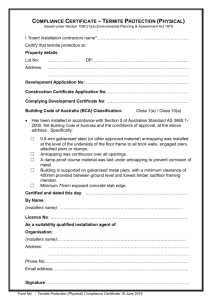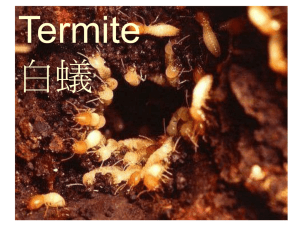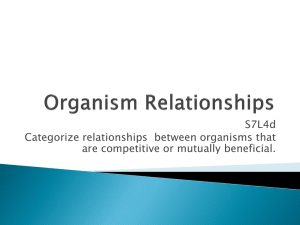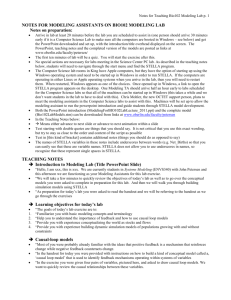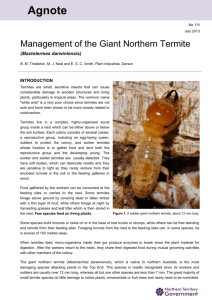Termites - Fox Blocks
advertisement
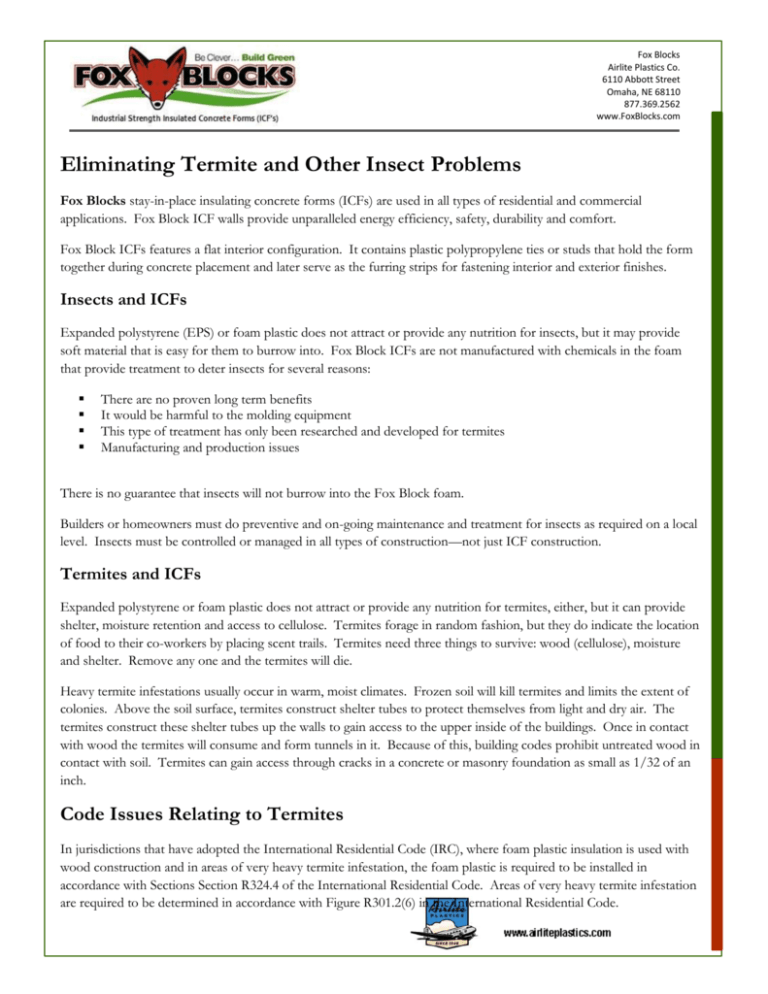
Fox Blocks Airlite Plastics Co. 6110 Abbott Street Omaha, NE 68110 877.369.2562 www.FoxBlocks.com Eliminating Termite and Other Insect Problems Fox Blocks stay-in-place insulating concrete forms (ICFs) are used in all types of residential and commercial applications. Fox Block ICF walls provide unparalleled energy efficiency, safety, durability and comfort. Fox Block ICFs features a flat interior configuration. It contains plastic polypropylene ties or studs that hold the form together during concrete placement and later serve as the furring strips for fastening interior and exterior finishes. Insects and ICFs Expanded polystyrene (EPS) or foam plastic does not attract or provide any nutrition for insects, but it may provide soft material that is easy for them to burrow into. Fox Block ICFs are not manufactured with chemicals in the foam that provide treatment to deter insects for several reasons: There are no proven long term benefits It would be harmful to the molding equipment This type of treatment has only been researched and developed for termites Manufacturing and production issues There is no guarantee that insects will not burrow into the Fox Block foam. Builders or homeowners must do preventive and on-going maintenance and treatment for insects as required on a local level. Insects must be controlled or managed in all types of construction—not just ICF construction. Termites and ICFs Expanded polystyrene or foam plastic does not attract or provide any nutrition for termites, either, but it can provide shelter, moisture retention and access to cellulose. Termites forage in random fashion, but they do indicate the location of food to their co-workers by placing scent trails. Termites need three things to survive: wood (cellulose), moisture and shelter. Remove any one and the termites will die. Heavy termite infestations usually occur in warm, moist climates. Frozen soil will kill termites and limits the extent of colonies. Above the soil surface, termites construct shelter tubes to protect themselves from light and dry air. The termites construct these shelter tubes up the walls to gain access to the upper inside of the buildings. Once in contact with wood the termites will consume and form tunnels in it. Because of this, building codes prohibit untreated wood in contact with soil. Termites can gain access through cracks in a concrete or masonry foundation as small as 1/32 of an inch. Code Issues Relating to Termites In jurisdictions that have adopted the International Residential Code (IRC), where foam plastic insulation is used with wood construction and in areas of very heavy termite infestation, the foam plastic is required to be installed in accordance with Sections Section R324.4 of the International Residential Code. Areas of very heavy termite infestation are required to be determined in accordance with Figure R301.2(6) in the International Residential Code. Fox Blocks Airlite Plastics Co. 6110 Abbott Street Omaha, NE 68110 877.369.2562 www.FoxBlocks.com Exterior expanded polystyrene (EPS) foam may not be installed on the exterior face or under interior or exterior foundation walls or slab foundations located below grade. The clearance of foam plastics installed above grade and exposed earth must be at least six inches. Exceptions: 1. Buildings where the structural members of walls, floors, ceilings and roofs are entirely of noncombustible materials (i.e. metal) or pressure preservative treated wood. 2. When in addition to the requirements of R324.1, an approved method of protecting the foam plastic and structure from subterranean termite damage is provided (i.e. Polyguard, an ICF waterproofing and termite protection product). 3. On the interior side of basement walls. What is the Insulating Concrete Form Industry Doing? The ICF industry has developed a list of termite control options. In very heavily infested areas indicated by the International Residential Code, only two options are allowed—building without wood, or using an approved method of termite protection. Individual ICF companies are working to develop construction techniques and methods to prevent termite infestation in buildings constructed with ICF systems. A Joint Industry Task Force has been set up by the Termite Committee of the Foamed Polystyrene Alliance and the Wood Destroying Organisms Committee of the National Pest Control Association. What is Fox Blocks Doing? Proactively educating and providing information to our sales force and network of building professionals Staying abreast of the issue and continuing to look for additional solutions Recommendations for Treatment and Prevention 1. The best solution when building below grade in the areas of very heavy termite infestation as determined by the national model building codes or in other areas where there is concern for termites is to use the Polyguard Products, Inc. 650 XTM or 650 XTP waterproofing and termite protection membrane. These two products have been evaluated and approved by SBCCI PST & ES to be used as both a waterproofing and a termite protection membrane for ICFs. The SBCCI PST & ES evaluation report number is #2136. This product satisfies the requirement for use of ICFs below grade in the parts of the country determined to be very heavy infestation termite areas (see Code Issues, exception #2). Polyguard Products, Inc. can be reached at 1-800541-4994. 2. Check with the local building official in the jurisdiction in which you are building. Ask them about any requirements for termite and other pretreatments and control measures. Follow these requirements. Fox Blocks Airlite Plastics Co. 6110 Abbott Street Omaha, NE 68110 877.369.2562 www.FoxBlocks.com Fox Blocks Airlite Plastics Co. 6110 Abbott Street Omaha, NE 68110 877.369.2562 www.FoxBlocks.com 3. Check with the lending institution that will carry the mortgage on any new building to see if there is a termite or other insect guarantee requirement. If so, find a reputable local pest control operator (PCO) and get a commitment to issue a guarantee acceptable to the lender. Arrange for the required termite control measures. Some jurisdictions may not require control measures. Nevertheless, the builder and/or the ICF installer may be liable for termite damage and should consult with local experts and take appropriate precautions. In the case of Veterans Administration and HUD projects, pretreatments are required and the builder, not the PCO must issue a five year termite warranty. 4. Soil treatment is the primary defense against termites and other pests. Therefore, prior to placing concrete, the soil near footings and under basement floors, porches, stoops, patios, and garage floors should be treated with proper chemicals. After construction of the walls, all of the soil in contact with the walls should be treated on a scheduled basis. 5. A termite barrier can be installed into the form system. This can be accomplished by using a metal termite shield embedded into the foam to the concrete. Another method is to create a 2 to 4 inch (51 to 102 mm) concrete barrier along the perimeter of the ICF foundation wall just above grade. This is done by removing the EPS foam forming the gap created and placing the concrete out to the face of the ICF wall. Termite barriers force termites to funnel out and around the barrier so that they can be seen. 6. Standard maintenance around the building is also helpful. Do not store firewood or lumber near buildings and keep moisture and water away from buildings.
